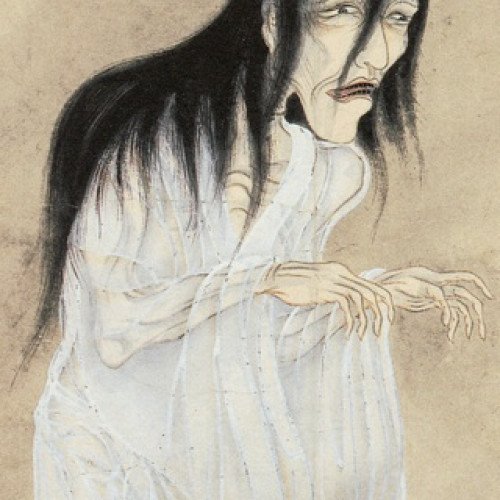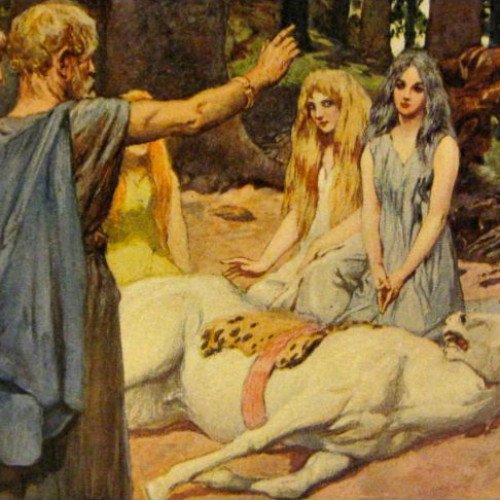Ghost VS German (mythology)

Ghost
In folklore, a ghost is the soul or spirit of a dead person or animal that can appear to the living. In ghostlore, descriptions of ghosts vary widely from an invisible presence to translucent or barely visible wispy shapes, to realistic, lifelike forms. The deliberate attempt to contact the spirit of a deceased person is known as necromancy, or in spiritism as a séance. Other terms associated with it are apparition, haunt, phantom, poltergeist, shade, specter or spectre, spirit, spook, and wraith. The belief in the existence of an afterlife, as well as manifestations of the spirits of the dead, is widespread, dating back to animism or ancestor worship in pre-literate cultures. Certain religious practices—funeral rites, exorcisms, and some practices of spiritualism and ritual magic—are specifically designed to rest the spirits of the dead. Ghosts are generally described as solitary, human-like essences, though stories of ghostly armies and the ghosts of animals rather than humans have also been recounted. They are believed to haunt particular locations, objects, or people they were associated with in life. According to a 2009 study by the Pew Research Center, 18% of Americans say they have seen a ghost.The overwhelming consensus of science is that there is no proof that ghosts exist. Their existence is impossible to falsify, and ghost hunting has been classified as pseudoscience. Despite centuries of investigation, there is no scientific evidence that any location is inhabited by spirits of the dead. Historically, certain toxic and psychoactive plants (such as datura and hyoscyamus niger), whose use has long been associated with necromancy and the underworld, have been shown to contain anticholinergic compounds that are pharmacologically linked to dementia (specifically DLB) as well as histological patterns of neurodegeneration. Recent research has indicated that ghost sightings may be related to degenerative brain diseases such as Alzheimer's disease. Common prescription medication and over-the-counter drugs (such as sleep aids) may also, in rare instances, cause ghost-like hallucinations, particularly zolpidem and diphenhydramine. Older reports linked carbon monoxide poisoning to ghost-like hallucinations.In folklore studies, ghosts fall within the motif index designation E200-E599 ("Ghosts and other revenants").
Statistics for this Xoptio

German (mythology)
German (GERMAN, pronounced [ˈɡerman]) is a South Slavic mythological being, recorded in the folklore of eastern Serbia and northern Bulgaria. He is a male spirit associated with bringing rain and hail. His influence on these precipitations can be positive, resulting in the amount of rain beneficial for agriculture, or negative, with a drought, downpours, or hail. Rituals connected with German included making a doll intended to represent this personage. This effigy of German, made of rags, fired clay, or dried fruits, was rather large, usually with a distinct representation of the male genitals. It was produced and used in rituals exclusively by girls or young women.In Eastern Serbia , when a drought developed, girls would make such a doll, and bring it to a river bank. Depending on the regional custom, they would either bury it by the river, or put it in a little coffin and let it float down the river. Two of the girls would then start lamenting for the doll. Asked by the others why they were crying, they would answer, "We are crying for German; because of the drought German has died so that the rain may fall." If the amount of rain falling should then become excessive, the doll would be dug up again. In northern Bulgaria, the rituals with German usually followed immediately after the Dodola rituals, but could be performed independently from them. In some villages they were carried out on the Feast of Saint Germanus. Girls would make the doll, 20 to 50 cm long, and lay it on a slate or in a little coffin. Having adorned it with flowers, they would bury it with funeral observances. After three, nine, or forty days, the doll was dug up and thrown into water.People would also try to ward off destructive summer hailstorms by placating German with a ritual performed on Christmas Eve. This ritual was recorded in the area around Pirot at the beginning of the 20th century. Immediately before the start of the Christmas Eve dinner, the head of the household would go out to his woodpile, to invite German to dinner. He would take with him a loaf of bread called "good luck", prepared particularly for this ritual, slivovitz, wine, and a wax candle. At the woodpile, he would shout three times, "German, German, wherever you are, come to dinner right now, and in the summer do not let me see your eyes anywhere!" He would then light the candle, take a sip of slivovitz, taste some bread, drink wine, and go back into his house. Asked how he had fared in his encounter with German, he would answer, "He came, so we dined and drank amply of slivovitz and wine, and then we parted."German, who dies so that the nature may regenerate with the falling of rain, can be understood as a spirit of vegetation, dying and then resurrecting with the revival of vegetation. His distinctly represented male genitals symbolize fertility. The doll of German is presumably a metaphorical replacement of the former human sacrifice. It can be included among the Slavic sacrificial dolls, together with the dolls of Yarilo, Kostroma, and Morena.In Christianized folk beliefs German is identified with Saint Germanus. This saint is associated with the protection from hail, and occasionally from lightning, though the latter was generally ascribed to Saint Elijah.